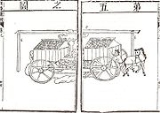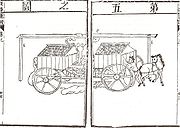
Johann Schreck
Encyclopedia
Johann Schreck, also Terrenz or Terrentius Constantiensis, Deng Yuhan Hanpo, Deng Zhen Lohan, (1576, Bingen, Baden-Württemberg
or Constance
– 11 May 1630, Beijing
) was a German Jesuit, missionary to China and polymath
. He is credited with the discovery of the scientific-technical terminology.
 Schreck studied medicine starting 1590 at the Albert Ludwigs University of Freiburg, the University of Altdorf
Schreck studied medicine starting 1590 at the Albert Ludwigs University of Freiburg, the University of Altdorf
and after 1603 in Padua
. He became a highly respected medic and was affiliated to the scientific society the Accademia dei Lincei
in Rome
, whose other members included Galileo Galilei
. At this academy he worked on the encyclopaedia of botany
Rerum medicarum Novae Hispaniae Thesaurus alongside Francisco Hernández de Toledo
.
To everyone's surprise (Galileo wrote: "Una gran perdita" - "a big loss"), Schreck became a Jesuit, to go to China as a missionary. He met the Belgian Pater Nicolas Trigault
in 1614, with whom he prepared his scientific mission. He started his journey to China in April 1618 from Lisbon
. After several pirate incidents and epidemics Schreck arrived in October 1618 in Goa
, where he began his opus Plinius Indicus, a botanic and zoological encyclopaedia about Asia, which he was never able to finish. On 22 July 1619 they reached Macau
. In 1621 he arrived in Hangzhou
, and in late 1623 Beijing
.
Schreck was able to achieve enormous language skills; he was fluent in German, Italian, Portuguese, French and English. He wrote his letters in Latin
. He also mastered the source languages of Christianity, namely Greek, Hebrew and Biblical Aramaic
. Later in his life, he learned Chinese.
At the beginning of the 17th century, he wrote and translated several Chinese textbooks on mathematics, engineering, medicine and astronomy alongside Nicolò Longobardo
and Chinese scholars. He was in contact with all important scientists of his time: Johannes Kepler
sent his newest astronomic opus, the "Rudolphine Tables
" to China, which, however, he was not able to receive: they arrived in Macau 16 years after Schreck's death. Schreck is said to have died of a medical experiment on himself. He is laid to rest on the Beijing cemetery of Zhalan.
Bingen, Baden-Württemberg
Bingen is a municipality in the district of Sigmaringen in Baden-Württemberg in Germany.-Points of interest:* Hornstein Castle Ruin, first noted in 1271, a former Reichsfestung. Between 1818 and 1869 the castle served as an asylum and prison. It was partly demolished in 1879. The castle's chapel...
or Constance
Constance
Constance is a female given name that derives from Latin and means "constant." Variations of the name include Connie, Constancia, Constanze, Constanza, Stanzy, and Konstanze.Constance may refer to:-People:*Constance Bennett , American actress...
– 11 May 1630, Beijing
Beijing
Beijing , also known as Peking , is the capital of the People's Republic of China and one of the most populous cities in the world, with a population of 19,612,368 as of 2010. The city is the country's political, cultural, and educational center, and home to the headquarters for most of China's...
) was a German Jesuit, missionary to China and polymath
Polymath
A polymath is a person whose expertise spans a significant number of different subject areas. In less formal terms, a polymath may simply be someone who is very knowledgeable...
. He is credited with the discovery of the scientific-technical terminology.
Life

University of Altdorf
The University of Altdorf was a university in Altdorf bei Nürnberg, a small town outside Nuremberg. It was founded in the late 16th century, received university privileges in 1622 and was closed in 1809 by Maximilian I Joseph of Bavaria....
and after 1603 in Padua
Padua
Padua is a city and comune in the Veneto, northern Italy. It is the capital of the province of Padua and the economic and communications hub of the area. Padua's population is 212,500 . The city is sometimes included, with Venice and Treviso, in the Padua-Treviso-Venice Metropolitan Area, having...
. He became a highly respected medic and was affiliated to the scientific society the Accademia dei Lincei
Accademia dei Lincei
The Accademia dei Lincei, , is an Italian science academy, located at the Palazzo Corsini on the Via della Lungara in Rome, Italy....
in Rome
Rome
Rome is the capital of Italy and the country's largest and most populated city and comune, with over 2.7 million residents in . The city is located in the central-western portion of the Italian Peninsula, on the Tiber River within the Lazio region of Italy.Rome's history spans two and a half...
, whose other members included Galileo Galilei
Galileo Galilei
Galileo Galilei , was an Italian physicist, mathematician, astronomer, and philosopher who played a major role in the Scientific Revolution. His achievements include improvements to the telescope and consequent astronomical observations and support for Copernicanism...
. At this academy he worked on the encyclopaedia of botany
Botany
Botany, plant science, or plant biology is a branch of biology that involves the scientific study of plant life. Traditionally, botany also included the study of fungi, algae and viruses...
Rerum medicarum Novae Hispaniae Thesaurus alongside Francisco Hernández de Toledo
Francisco Hernández de Toledo
Francisco Hernández de Toledo was a naturalist and court physician to the King of Spain....
.
To everyone's surprise (Galileo wrote: "Una gran perdita" - "a big loss"), Schreck became a Jesuit, to go to China as a missionary. He met the Belgian Pater Nicolas Trigault
Nicolas Trigault
Nicolas Trigault was a Flemish Jesuit, and a missionary to China. He was also known by his latinised name Trigautius or Trigaultius, and his Chinese name Jīn Nígé .-Life and work:...
in 1614, with whom he prepared his scientific mission. He started his journey to China in April 1618 from Lisbon
Lisbon
Lisbon is the capital city and largest city of Portugal with a population of 545,245 within its administrative limits on a land area of . The urban area of Lisbon extends beyond the administrative city limits with a population of 3 million on an area of , making it the 9th most populous urban...
. After several pirate incidents and epidemics Schreck arrived in October 1618 in Goa
Goa
Goa , a former Portuguese colony, is India's smallest state by area and the fourth smallest by population. Located in South West India in the region known as the Konkan, it is bounded by the state of Maharashtra to the north, and by Karnataka to the east and south, while the Arabian Sea forms its...
, where he began his opus Plinius Indicus, a botanic and zoological encyclopaedia about Asia, which he was never able to finish. On 22 July 1619 they reached Macau
Macau
Macau , also spelled Macao , is, along with Hong Kong, one of the two special administrative regions of the People's Republic of China...
. In 1621 he arrived in Hangzhou
Hangzhou
Hangzhou , formerly transliterated as Hangchow, is the capital and largest city of Zhejiang Province in Eastern China. Governed as a sub-provincial city, and as of 2010, its entire administrative division or prefecture had a registered population of 8.7 million people...
, and in late 1623 Beijing
Beijing
Beijing , also known as Peking , is the capital of the People's Republic of China and one of the most populous cities in the world, with a population of 19,612,368 as of 2010. The city is the country's political, cultural, and educational center, and home to the headquarters for most of China's...
.
Schreck was able to achieve enormous language skills; he was fluent in German, Italian, Portuguese, French and English. He wrote his letters in Latin
Latin
Latin is an Italic language originally spoken in Latium and Ancient Rome. It, along with most European languages, is a descendant of the ancient Proto-Indo-European language. Although it is considered a dead language, a number of scholars and members of the Christian clergy speak it fluently, and...
. He also mastered the source languages of Christianity, namely Greek, Hebrew and Biblical Aramaic
Biblical Aramaic
Biblical Aramaic is the form of the Aramaic language that is used in the books of Daniel, Ezra and a few other places in the Hebrew Bible and should not be confused with the Aramaic translations of the Hebrew Bible known as targumim....
. Later in his life, he learned Chinese.
At the beginning of the 17th century, he wrote and translated several Chinese textbooks on mathematics, engineering, medicine and astronomy alongside Nicolò Longobardo
Nicolò Longobardo
Nicolò Longobardo was an Sicilian Jesuit in China in the 17th century. He arrived in China in 1597, and was sent to the area of Shaozhou...
and Chinese scholars. He was in contact with all important scientists of his time: Johannes Kepler
Johannes Kepler
Johannes Kepler was a German mathematician, astronomer and astrologer. A key figure in the 17th century scientific revolution, he is best known for his eponymous laws of planetary motion, codified by later astronomers, based on his works Astronomia nova, Harmonices Mundi, and Epitome of Copernican...
sent his newest astronomic opus, the "Rudolphine Tables
Rudolphine Tables
The Rudolphine Tables consist of a star catalogue and planetary tables published by Johannes Kepler in 1627 using data from Tycho Brahe's observations.-Previous tables:...
" to China, which, however, he was not able to receive: they arrived in Macau 16 years after Schreck's death. Schreck is said to have died of a medical experiment on himself. He is laid to rest on the Beijing cemetery of Zhalan.
See also
- Rainer-K. Langner: Kopernikus in der Verbotenen Stadt. Wie der Jesuit Johannes Schreck das Wissen der Ketzer nach China brachte. S. Fischer Verlag, Frankfurt 2007 ISBN 3100439325 ISBN 978-3100439321
- Isaïa Iannaccone: L'ami de Galilée 2008 Livre de Poche ISBN :2253120111

